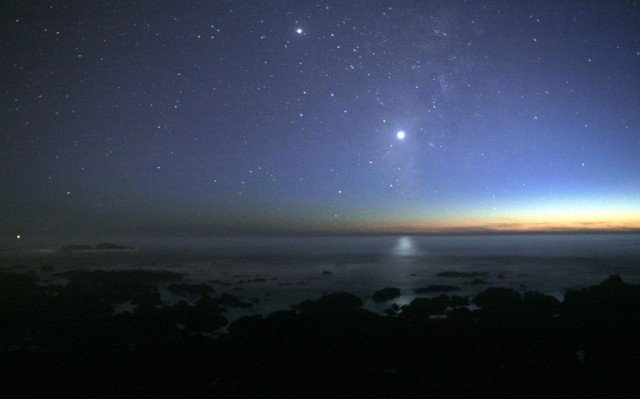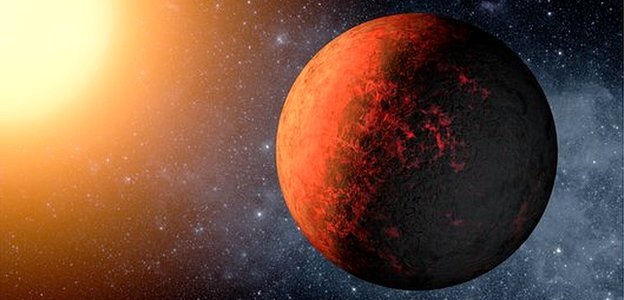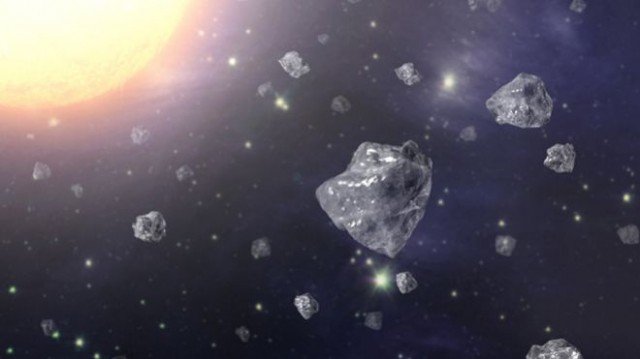This weekend, Venus is about as bright as it can get.
Venus is an unusually bright evening star this month because it’s swinging toward Earth in its orbit.

Venus is about as bright as it can get
That means its apparent size is increasing, and it’s still at an angle that reflects a healthy fraction of the sun’s rays.
Every night, Venus will be lower in the sky when the sun sets, and by January 2014 it will be lost in the sun’s glare.
Astronomers may have discovered one of the richest planetary systems yet.
The discovery of a seventh planet around the dwarf star KIC 11442793 could be a record, according to two separate teams of researchers.
The system bears some similarities to our own, but all seven planets orbit much closer to their host star, which lies some 2,500 light-years from Earth.
The crowded solar system is described in two papers published on the pre-print server Arxiv.org.
One of the identifications was made by volunteers using the Planet Hunters website. The site was set up to allow volunteers to sift through the public data from NASA’s Kepler space telescope – which was launched to search for so-called exoplanets – worlds orbiting distant stars.
Kepler uses the transit method to discover new planets, which entails looking for the dip in light as an alien world passes in front of its host star. But there is simply too much data for mission scientists to examine every light curve, so they developed computer programmes to search for the signature of a planetary transit.
“This is the first seven-planet system from Kepler, using a transiting search. We think [the identification] is very secure,” said Dr. Chris Lintott, from the University of Oxford, co-author on the Planet Hunters paper.

Astronomers may have discovered one of the richest planetary systems yet
“With a transiting system, once you get multiple planets, the odds of them being false positives are very small.”
Dr. Chris Lintott’s team has submitted their research to the Astronomical Journal for peer review. Another team of astronomers from several European countries has submitted a separate paper outlining their independent discovery of the seventh planet to the Astrophysical Journal.
The new planet is the fifth furthest from its parent star, orbiting with a period of nearly 125 days.
With a radius of 2.8 times that of the Earth, it fits into a family that now includes two roughly Earth sized worlds, three “super-Earths” and two larger bodies.
“It actually looks like our Solar System in one sense, with all the small planets on the inside and the big planets on the outside. And that’s not necessarily what we always see,” said co-author Robert Simpson, also from Oxford University.
While there might be resemblances to our Solar System, all seven planets are closer to their host star. In fact they would all fit within the Earth’s distance from the Sun, making this a very crowded neighborhood.
“This is one of the reasons they are easy to see, because the closer they are to their sun, the more frequently they go around it,” said Robert Simpson.
However, the Planet Hunters team carried out simulations showing that the planetary system should be a stable one.
Dr. Chris Lintott added: “Everything we know about this system tells us [the seventh planet] should have been found using the automatic detection routines. But it wasn’t.”
“A seven-planet system is very complicated so you get a sense of why the automatic routine might have missed out – it gets confused by the presence of the other transits.
“Looking for these transits seems like a task that’s perfectly designed for computers. But we keep finding, in these niche cases, in these odd cases, in these complicated cases that humans can beat the computers.”
Another star, HD 10180, has been claimed to have either seven, or nine planetary signals. A distant sun called GJ 887C may also have a family of seven planets.
According to US scientists, diamonds big enough to be worn by Hollywood film stars could be raining down on Saturn and Jupiter.
New atmospheric data for the gas giants indicates that carbon is abundant in its dazzling crystal form, they say.
Lightning storms turn methane into soot (carbon) which as it falls hardens into chunks of graphite and then diamond.
These diamond “hail stones” eventually melt into a liquid sea in the planets’ hot cores, they told a conference.
The biggest diamonds would likely be about a centimetre in diameter – “big enough to put on a ring, although of course they would be uncut,” says Dr. Kevin Baines, of the University of Wisconsin-Madison and NASA’s Jet Propulsion Laboratory.
Kevin Baines added they would be of a size that the late film actress Elizabeth Taylor would have been “proud to wear”.
“The bottom line is that 1,000 tonnes of diamonds a year are being created on Saturn.
“People ask me – how can you really tell? Because there’s no way you can go and observe it.

Diamonds big enough to be worn by Hollywood film stars could be raining down on Saturn and Jupiter
“It all boils down to the chemistry. And we think we’re pretty certain.”
Kevin Baines presented his unpublished findings at the annual meeting of the Division for Planetary Sciences of the American Astronomical Society in Denver, Colorado, alongside his co-author Mona Delitsky, from California Speciality Engineering.
Uranus and Neptune have long been thought to harbor gemstones. But Saturn and Jupiter were not thought to have suitable atmospheres.
Kevin Baines and Mona Delitsky analyzed the latest temperature and pressure predictions for the planets’ interiors, as well as new data on how carbon behaves in different conditions.
They concluded that stable crystals of diamond will “hail down over a huge region” of Saturn in particular.
“It all begins in the upper atmosphere, in the thunderstorm alleys, where lightning turns methane into soot,” said Kevin Baines.
“As the soot falls, the pressure on it increases. And after about 1,000 miles it turns to graphite – the sheet-like form of carbon you find in pencils.”
By a depth of 6,000km, these chunks of falling graphite toughen into diamonds – strong and unreactive.
These continue to fall for another 30,000km – “about two-and-a-half Earth-spans” says Kevin Baines.
“Once you get down to those extreme depths, the pressure and temperature is so hellish, there’s no way the diamonds could remain solid.
“It’s very uncertain what happens to carbon down there.”
One possibility is that a “sea” of liquid carbon could form.
“Diamonds aren’t forever on Saturn and Jupiter. But they are on Uranus and Neptune, which are colder at their cores,” says Kevin Baines.
[youtube zQGiuQQD6ec]



